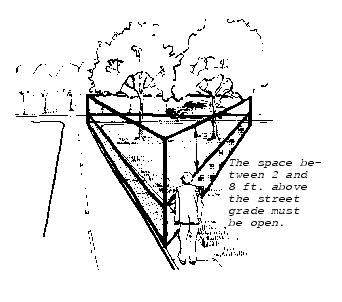20D.210.25 Sight Clearance at Intersections.
20D.210.25-010 Purpose.
The purpose of this section is to improve traffic safety at intersections. (Formerly 20C.20.220(05))
20D.210.25-020 Intersection.
For the purpose of this section, intersections shall mean where two public and/or private alleys, roads, streets, or nonresidential driveways meet or cross. (Formerly 20C.20.220(10))
20D.210.25-030 Obstruction of Intersection.
The obstruction of a motor vehicle operator’s view at an intersection shall be prohibited within the “Sight Distance Triangle” described in this section between a height of two feet and eight feet above existing street grade. Sight obstructions that shall be excluded from the “Sight Distance Triangle” include parked vehicles, signs, fences, hedges, shrubs, natural vegetation and trees and other inanimate objects greater than one foot in width. Sight obstructions that are permitted in the “Sight Distance Triangle” include utility poles, traffic control devices, trees and other inanimate objects 1.5 feet or less in width and spaced at least 50 feet apart. (Formerly 20C.20.220(15))
20D.210.25-040 Sight Distance Triangle.
|
Type of Intersection |
Horizontal Sight |
|
|
Controlled by |
(a) |
(b) |
|
Traffic Signal or Stop Sign |
|
|
|
Intersections that Involve Arterials (30MPH+) |
20' |
100' |
|
Others (Local access, driveways, etc.) (25 MPH) |
20' |
65' |
|
Uncontrolled or Yield Right-of-Way (Local access – residential) |
70' |
70' |
The sight distance triangle is described by two intersecting lines of a specified length (a) and (b) which correspond to the straight line projections of the pavement edges and a third line which connects the extremities of the other two without overlaying the pavement. The location of the pavement edge shall be for a fully developed street that meets City standards for the classification, whether it is in fact completed or not. (Formerly 20C.20.220(20))

20D.210.25-050 Vertical Sight Distance at Intersections.
(1) Minimum vertical sight distances shall be established by the Department of Public Works consistent with legal vehicular speeds and stopping sight distance.
(2) These standards shall be published, placed in the appendix of the Development Guide and be made available to the public. (Formerly 20C.20.220(25))
20D.210.25-060 Special Cases.
Where unusual conditions preclude the application of this section in a reasonable manner, the Department of Public Works may establish minimum sight distances based on the intent of this section. These minimum sight distances may be more restrictive than provided in RCDG 20D.210.25-040. (Formerly 20C.20.220(30))


